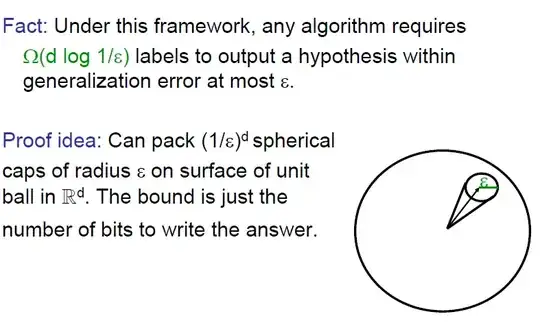it shouldn't be too hard to derive.
I tried not to hard to derive it, but failed. Moreover, I think that the proposed bound is wrong. Below are my calculations.
Note that when $\tfrac 1\varepsilon$ is not an integer then there is no sense to pack $\tfrac 1{\varepsilon^n}$-many caps, so we try to pack at least so many caps.
Since for $n\ge 2$ it is hard to provide explicit coordinates of the centers of packed caps, we try to obtain the required bound comparing ($n$-dimensional) areas. Unfortunately, an observation that an area of a cap is less that $\tfrac 1m$ area of a sphere should not imply that we can pack $m$ copies of the cap on the sphere, so we should use the following trick.
We assume that a radius of a spherical cap its a distance from its center on a sphere to its boundary point.
Given $\varepsilon$, let $X$ be any maximal subset of $S^n$ such that the distance between any two distinct points of $X$ is at most $\color{red}2\varepsilon$. Then (open) spherical caps of radius $\varepsilon$ centered at points of $X$ are pairwise disjoint. So we have to show that $|X|\ge \tfrac 1{\varepsilon^{n+1}}$.
The maximality of $X$ implies that a union of closed spherical caps of radius $2\varepsilon$ centered at points of $X$ covers $S^n$. We have that $n$-dimensional area of $S^n$ equals $A_{n+1}=\frac{2\pi^{(n+1)/2}}{\Gamma\left(\tfrac {n+1}2\right)}$. The formula for the area $C_{n+1}$ of the spherical cap of a given radius is even more complicated. In particular, it involves a regularized incomplete beta function. In order to esimate it, we use a formula $C_{n+1}=\frac{2\pi^{n/2}}{\Gamma\left(\tfrac n2\right)}\int_0^\phi\sin^{n-1} \theta d\theta$ of Li’s paper, where, as I understood, $2\phi$ is the angle spanned by the cap, which follows $\varepsilon =\sin \phi/2$. The area comparison provides us a bound $|X|\ge A_{n+1}/C_{n+1}$. But for fixed $n$ and small $\varepsilon$ (and so $\phi$ and $\theta$), we have $\sin\theta\approx\theta$, so $$\int_0^\phi\sin^{n-1} \theta d\theta\approx \int_0^\phi \theta^{n-1} d\theta=\frac{\phi^n}n\approx \frac{(2\varepsilon)^n}n .$$
Since $\Gamma\left(\tfrac n2\right)\le \Gamma\left(\tfrac {n+1}2\right)$ for $n\ge 3$, we have
$$\frac {A_{n+1}}{C_{n+1}}\approx \frac{2\pi^{(n+1)/2}}{\Gamma\left(\tfrac {n+1}2\right)} \cdot \frac {\Gamma\left(\tfrac n2\right)} {2\pi^{n/2}}\cdot \frac n{(2\varepsilon)^n}\le \frac {n\sqrt{\pi}}{(2\varepsilon)^n},$$
which is smaller than the required bound $\tfrac 1{\varepsilon^{n+1}}$, provided $\varepsilon\le \frac{2^n}{n\sqrt{\pi}}$.
Moreover, replacing in the above calculations $2\varepsilon$ by $\varepsilon$, we see that we even cannot pack on $S^n$ more than $\approx \frac {n\sqrt{\pi}}{\varepsilon^n}$ caps, which is smaller
than the required bound $\tfrac 1{\varepsilon^{n+1}}$, provided $\varepsilon\le \frac{1}{n\sqrt{\pi}}$.
